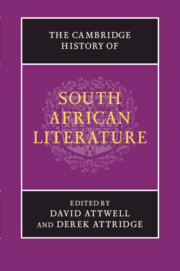Book contents
- Frontmatter
- Introduction
- PART I ORATURES, ORAL HISTORIES, ORIGINS
- PART II EXPLORATION, EARLY MODERNITY AND ENLIGHTENMENT AT THE CAPE, 1488–1820
- PART III EMPIRE, RESISTANCE AND NATIONAL BEGINNINGS, 1820–1910
- PART IV MODERNISM AND TRANSNATIONAL CULTURE, 1910–1948
- PART V APARTHEID AND ITS AFTERMATH, 1948 TO THE PRESENT
- 19 The fabulous fifties: short fiction in English
- 20 Writing in exile
- 21 Afrikaans literature, 1948–1976
- 22 Afrikaans literature after 1976: resistances and repositionings
- 23 The liberal tradition in fiction
- 24 Black Consciousness poetry: writing against apartheid
- 25 Popular forms and the United Democratic Front
- 26 Writing the prison
- 27 Theatre: regulation, resistance and recovery
- 28 The lyric poem during and after apartheid
- 29 Writing and publishing in African languages since 1948
- 30 Writing the interregnum: literature and the demise of apartheid
- 31 Rewriting the nation
- 32 Writing the city after apartheid
- PART VI SOUTH AFRICAN LITERATURE: CONTINUITIES AND CONTRASTS
- Index
- References
27 - Theatre: regulation, resistance and recovery
from PART V - APARTHEID AND ITS AFTERMATH, 1948 TO THE PRESENT
Published online by Cambridge University Press: 28 January 2012
- Frontmatter
- Introduction
- PART I ORATURES, ORAL HISTORIES, ORIGINS
- PART II EXPLORATION, EARLY MODERNITY AND ENLIGHTENMENT AT THE CAPE, 1488–1820
- PART III EMPIRE, RESISTANCE AND NATIONAL BEGINNINGS, 1820–1910
- PART IV MODERNISM AND TRANSNATIONAL CULTURE, 1910–1948
- PART V APARTHEID AND ITS AFTERMATH, 1948 TO THE PRESENT
- 19 The fabulous fifties: short fiction in English
- 20 Writing in exile
- 21 Afrikaans literature, 1948–1976
- 22 Afrikaans literature after 1976: resistances and repositionings
- 23 The liberal tradition in fiction
- 24 Black Consciousness poetry: writing against apartheid
- 25 Popular forms and the United Democratic Front
- 26 Writing the prison
- 27 Theatre: regulation, resistance and recovery
- 28 The lyric poem during and after apartheid
- 29 Writing and publishing in African languages since 1948
- 30 Writing the interregnum: literature and the demise of apartheid
- 31 Rewriting the nation
- 32 Writing the city after apartheid
- PART VI SOUTH AFRICAN LITERATURE: CONTINUITIES AND CONTRASTS
- Index
- References
Summary
Although twentieth-century literary drama in English and Afrikaans appeared in separate milieus in print, on stage or in informal circulation, theatrical practice mixed indigenous forms like izibongo (praises) and ingoma (music) with modern inventions like vaudeville, minstrelsy and the jazz musical. This diversity reflected a syncretic history and hinted at an integrated future, despite the entrenchment of segregation. Whilst segregationists would have denied these facts, supporters of an integral South Africa found in theatre a place and occasion for staging unity in diversity and an alternative public sphere in a hostile state. Theatrical forms identified with South Africa in the last half-century have been thoroughly hybridised, whether in variations of international forms like satirical skits or intimate confessionals or in distinctly local transformations:
• the musical fuses ingoma ebusuku (literally: ‘music by night’; analytically: performance by professionals or aspirants in urban settings for cash) and the African American jazz revue to produce multilingual drama with songs, dance and dialogue.
• the testimonial play or theatre of witness, protest or resistance, testifies to individual and collective struggle, blending dialogue, narrative, and polemical statements; its trajectory includes Herbert Dhlomo's The Pass (1942), Athol Fugard's No-Good Friday (1958), as well as Survival (1976) and other collectively created plays, culminating in Born in the RSA (1986). The best bear powerful witness, but the relative authority and authorship of witness and interpreter remain controversial. (For these and other South African theatrical genres, see Kruger, Drama of South Africa, pp. 1–34, 86–99, 154–209)
- Type
- Chapter
- Information
- The Cambridge History of South African Literature , pp. 564 - 586Publisher: Cambridge University PressPrint publication year: 2012
References
- 1
- Cited by

